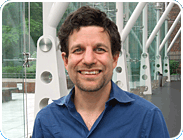Hi Aric,

How does the Sun affect the environment?
— Aric M., Grade 4
Astrophysicist Mordecai-Mark Mac Low answers this question:
Without the Sun , Earth's land, water, and air would all be frozen solid! Life on Earth would cease to exist. That's because almost all living things rely on the steady light and heat of the Sun. The Sun's heat makes liquid water on our planet possible. And all life that we know of — from bacteria to elephants — needs liquid water to survive.
Changes in the Sun's brightness can change global temperatures. Luckily, the Sun, like most middle-aged stars , shines steadily and reliably. Changes in its brightness are not causing global warming today, although they probably have in the distant past.

Almost all living things rely on the steady light and heat of the Sun.
Aside from its heat and visible light, the Sun also shines in ultraviolet (UV) light. Ozone in Earth's upper atmosphere blocks much of the UV. However, pollution can weaken the ozone shield. Then the Sun's UV light can harm living things on the ground and in the top layers of the oceans. Even when the ozone shield is strong, the UV that gets through help form smog from car exhausts and other pollution.
People can harness the heat and light of the Sun to generate electricity. Solar energy is becoming cheaper and more widespread. Someday it could supply most of our electricity. That would allow us to burn less fossil fuels like coal or oil. The burning of these fuels causes global warming by emitting carbon dioxide into the atmosphere, where it traps the Sun's heat.
Explore More:
- Get One-On-One With the Sun in this interview with our star.

Name:
Mordecai-Mark Mac Low
Job Title:
Curator and Chair, Department of Astrophysics
Known For:
Mordecai is an astrophysicist. He studies how planets, stars, and
galaxies
form.
Cool Fact:
Mordecai uses computers to simulate star formation. He also simulated the impact of
Comet
Shoemaker-Levy 9 into
Jupiter
! Some of Mordecai's simulations take four days to run even using a thousand computer processors at once.
Image Credits:
Sun, courtesy of NOAA; Mordecai-Mark Mac Low, © AMNH.




 Biodiversity
Biodiversity
 Brain
Brain
 Genetics
Genetics
 Marine BiOLogy
Marine BiOLogy
 MicrobiOLogy
MicrobiOLogy
 PaleontOLogy
PaleontOLogy
 ZoOLogy
ZoOLogy
 AnthropOLogy
AnthropOLogy
 ArchaeOLogy
ArchaeOLogy
 Astronomy
Astronomy
 Climate Change
Climate Change
 Earth
Earth
 Physics
Physics
 Water
Water
